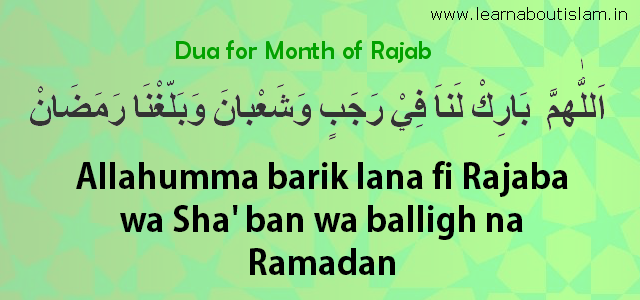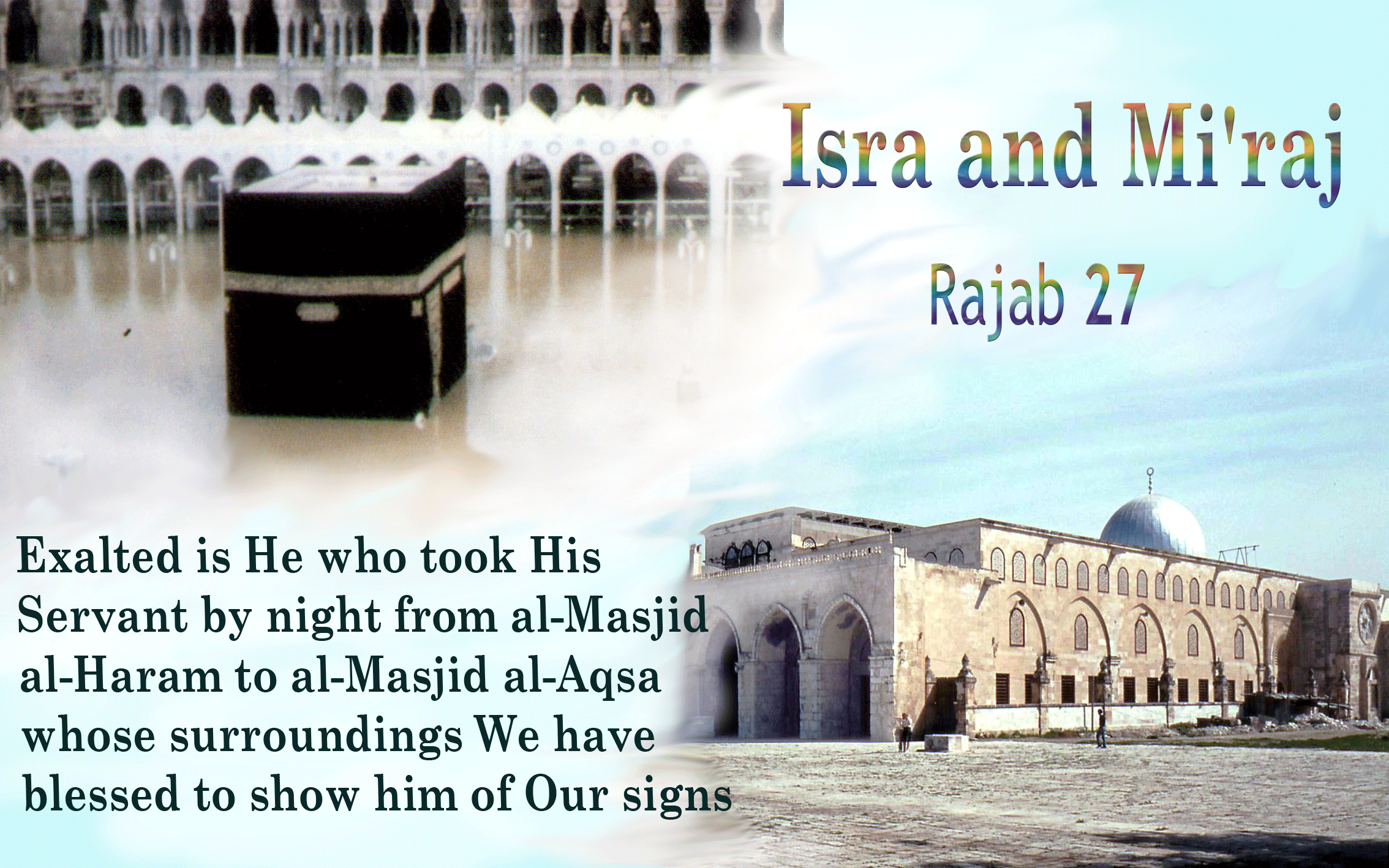Ref : Imamul Mufasireen Ash-Shiekh Tibri reported in”Jami’ul Bayan”
The word MEHRAJ(Ascent of Prophet Mohammed (Sallallahu alaihi wa sallam) is derived from Urooj, which means, ‘height’, ‘ascension’. It occurs in Hadith. The Quranic word for the event is ‘Israa’, meaning ‘the journey’. The event is briefly mentioned in the Qur’an, its detailed provided by Hadiths while the people’s fantasies add the usual garnishing. Taken from Qur’an and Hadiths the essential details of the event (with necessary explanation and discussions) are as follows;

The Heart Operation
The Angel Jibreel Alaihis Salaam alongwith two other angels visited the holy Prophet Mohammed (Sallallahu alaihi wa sallam) one night, while he was asleep in the Hateem part of Ka’abah. The angel then operated upon his heart and made some changes probably because the material body could not withstand the space travel with the required velocity without certain protection. The related part of the narration reads; “… Jibriel among them took upon himself to make a cut from the throat down to a part below the heart of the Prophet till he emptied the chest and the stomach. Then with his hands he washed it with Zamzam water till the stomach was cleaned. Then was brought a golden tray in which was a golden light filled with faith and wisdom. Pouring it inside, the chest and the veins of throat were filled up. Then the opened part was closed…” (Bukhari)
By incorporating the changes in the body system, his body was probably converted from material into Noorani (lightening) body to withstand the journey of space. It may be remembered that the material bodies of people destined for heavens would also be changed to lightening bodies after The Maidaan-e-Hash’r (The place of great gathering) before taking them to heavens.
Burraq
After the transformation of the body, a conveyance named Burraq was presented before him. Burraq, the narration says, resembled a horse-like animal but its very name indicates that it also possessed a lightening body. The word Burraq is derived from the root Bar’q which means ‘electricity’ in Arabic. Burraq signifies that he had to be taken with the velocity of Bar’q that is electricity or light which is 300,000 km per second.

In the Mosque of Jerusalem
No wonder, within no time he reached Baitul Maqdis or Masjid-e-Aqsa. The Qur’an has summarised the event in one verse; “Exalted is He (Allah) who took his bondsman (Muhammad) for a journey by night from Masjid-il-Haram (Ka’abah) to Masjid-il-Aqsa (the Mosque in Jerusalem), the neighbourhood whereof we have blessed, in order that we might show him our signs…” (17:1)
In Baitul Maqdis, the Prophet (Pbuh) led in prayer, all the earlier Prophets who were gathered for the occasion (naturally in their Barzakm or transitional and transcendental bodies). The journey from one holy Mosque to the other and the Prophet leading signifying that the inheritance of Divine leadership was being transferred to him from Bani Israel who no more deserved the honour.
Towards Heavens and Beyond
From there, he was raised to the heavens where he again met and conversed with different Prophets. Then came the most honoured moment of the journey as he was elevated to a point beyond heavens, called Sidrat-ul-Muntaha. What he observed there is described in Qur’an in the following words; “One free from any defect in body and mind then He (?) rose and became stable, While he was in the highest part of the horizon. Then he approached and came closer and was at a distance of two bows length or (even) closer. So, He (Allah) revealed to his bondsman (Muhammad) whatever he revealed. The Prophet’s heart lied not in what he saw. Will you then dispute with him (Muhammad) about what he saw? And indeed, he (Muhammad) saw him at a second descent near Sidrat-ul-Muntaha. Near it is Paradise of Abode. When that covered the Sidrah, which did cover it, the sight (of Prophet Muhammad) turned not aside nor it transgressed beyond the limit. Indeed he (Muhammad) did see of the greatest signs of his Lord (Allah)”. (53:6-18)
Whom did he meet? Allah or Jibriel?
There has been difference of opinion among scholars right from the days of Sahaba about whom the Prophet (Pbuh) met and saw at the place beyond heavens and horizon. Some say he saw Allah while others opine that he saw Jibriel in his original form. Ibne Abbas swore by the earlier while the Prophet’s wife Aisha strongly reprimanding the idea of physical sighting of Allah, favoured the latter opinion.
Both these assumptions invite serious apprehensions that could not be answered satisfactorily. Did the Prophet set eyes on Allah? Qur’an says; “No (material) vision can grasp him”. (6:103) When Prophet Musa (A.S) expressed his desire to see the Almighty, he said; “You can not (bear to) see me (in your material mould)”. (7:143). Those supporting the ‘saw Him’ theory say that it was an exclusive honour of Prophet Muhammad (Pbuh) alone and an exception that the Lord appeared for him. It may also be argued in the light of what I have written above that the holy Prophet, during Me’raj was in a spiritual mould. What goes against the idea of Allah’s appearance before the Prophet then? Well, primarily the holy Prophet (Pbuh) himself never claimed seeing Allah, while narrating the events of Me’raj. If he had, it would have been the most important part worth description. Secondly, none of the companions insisting on ‘Deedar’ (sighting) ascribe the claim to the Prophet. Instead, they say so based on conjectures. Thirdly, the Prophet’s wives should have been the first to be privy to such information if it was true. Not only none of them narrated thus but also Hazrat Aisha strongly denounced and even reprimanded such claims. Fourthly, the description in Qur’an, of the person, whom the Prophet (Pbuh) met in Me’raj seems too materialistic to fit the conception of Allah. Read them again; “.. Then he approached and came closer and was at a distance of two bows length or (even) closer..” And lastly, the Prophet himself denied that he saw Allah in Me’raj; “Narrated Abuzar that he asked the Prophet (Pbuh); Did you see your Lord? He replied; He is Noor. How can I see Him.” (Muslim)
Also Read Fasting on 27th of Rajab
The second theory of seeing Jibriel in his real form is also very unlikely. It is an anticlimax of a very extraordinary miracle described with much importance by Qur’an and Hadith. Seeing Hazrat Jibriel, a frequent visitor to the Prophet (Pbuh) (even in his original form) would not have been such a big event. The traditions also say that Hazrath Jibriel was not permitted to accompany the Prophet to Sidratul-Muntaha. He alone was elevated upto the all-important destination and hence the question of his seeing Jibriel there does not arise.
If neither Allah nor Jibriel, then who was he, whom the Prophet met there? Naturally some personage who is in between them both in stature, Haqeeqat-e-Ahmadi, of whom Muhammad r was a part and material manifestation. The Prophet (Pbuh) was informed and shown his own spiritual reality at Sidrat-ul-Muntaha. The Qur’an briefly mentions only the following; “So He (Allah) revealed to his bondsman (Muhammad) whatever he revealed… Indeed he (Muhammad) did see of the greatest signs of his Lord (Allah)”.
(And surely Allah alone knows the absolute truth.)
The Five times a day Salaat was ordained for the Ummah on the occasion. The Prophet (Pbuh) was also shown Paradise and Hell during the journey. After the great event he was again taken back to Ka’abah. The whole journey was completed within the night.
Other Prophets also travelled by Burraq
1. The other Prophets, whom Prophet met, were also there with their transcendental bodies, which could travel in space as he did. They also travelled back to heavens from Baitul Maqdis with the help of their Burraqs at lightning velocities. There is a mention of other Prophets also possessing Burraqs in Muslim, in the Hadith describing Me’raj, reported by Anas Bin Malik.
Nothing Unscientific
ii) Hadiths clearly state that Burraq is a mute-like animal. There is no mention of wings. Only earthly animals with material bodies need wings to fly against the gravitational force. The basic constituent of Burraq’s body, as the word indicates, is electrical energy, instead of the elements of earth. There is nothing unscientific about this. The realities pertaining to the subjects which science has not covered yet cannot be termed unscientific. Science has not comprehended till date, the subject of spirits and spiritual bodies. There are a large number of Allah’s creations that are invisible to human eyes, as human sight can only comprehend the matter and not energy. The angels and the Jinns possess non-material bodies constituted of light and heat energies. The existence of other beings should not be unbelievable.
Neither Dream Nor Awake
iii) The Qur’an in Surah Israa, in which the advent is mentioned, indicates the state in which the Prophet (Pbuh) was carried to his journey. It says; “… And we made not the vision which we showed you, but a trial for mankind..” (17:60)
It was neither a dream nor the state of wakefulness in the material sense. The Qur’anic word for the vision is ‘Ru’ya’ which is different from a dream. We find in one of the Hadiths describing Me’raj thus; “… They (the angels) came in such a state that the heart (of the Prophet) was seeing them. The eyes were asleep but the heart was awake. Likewise, the eyes of (all) the Prophets sleep but their hearts do not sleep..” (Bukhari; Kitab-ut-Tauhid; Narration of Abu Hurairah)
The above narration of Me’raj in Bukhari, which is a very lengthy one, ends with the following words; “..And when he (Muhammad r woke up, he was in Masjid-il-Haram (Ka’abah).” (Ibid).
So, the material body of the Prophet (Pbuh) was in a state of sleep after the Me’raj, while during the vision his transcendental body actually visited the places and witnessed the signs of Allah. In sleep he was taken and to sleep he was returned before and after the journey. During the journey, he was not asleep. He saw and witnessed everything with a transcendental body and with eyes, which were not material. Such is the vision of Prophets.
The Veracity of 27th Rajab
About the celebration, I must point out that there is not a single Hadith or authentic narration certifying the popular belief about 27th Rajab being the date of Me’raj. There are differences among scholars regarding the date, month and also the year of Me’raj. However, there is nothing against praying and glorifying the Lord and remembering the Prophet (Pbuh) on a particular night. At worst, it would be a distortion of a date in history, if the date is not actually true. It certainly is not a Bid’at unless the prayers of 27th Rajab are assumed to be obligatory part of Deen.
Ref :Mohammad Burhanuddin; Hubli
Ref: http://www.islamicvoice.com
Proof from QUR’AN
Here is proof from QUR’AN, A hadith-e-Nabawi (Sallallaho Alaihi Wasallam), Sayings of Sahab-e-Kiram and from the writings of great and authentic scholars of Islam that the Messenger of Allah Sallallahu Alaihi Wa Aalihi Wa Sallam did see ALLAH with his naked eyes and he also did proceed to the Divine Arsh on the night of Me’raaj.
The Holy Quran says:
سُبْحَانَ الَّذِي أَسْرَى بِعَبْدِهِ لَيْلا مِنَ الْمَسْجِدِ الْحَرَامِ إِلَى الْمَسْجِدِ الأقْصَى الَّذِي بَارَكْنَا حَوْلَهُ لِنُرِيَهُ مِنْ آيَاتِنَا إِنَّه هُوَ السَّمِيعُ الْبَصِيرُ
Holy is He who carried His bondman by night from the sacred Mosque to the Aqsa Mosque (Aqsa) around which We have put blessings that We might show him Our grand signs. No doubt, He is the Hearing, the Seeing. (Al Isra:1)
Imamul Mufasireen Ash-Shiekh Tibri reported in his commentary “Jami’ul Bayan”, “Meraaj was done with both body and soul. If a person says that it was only soul who did the Meraaj or it was only a dream then this will be an insignificant charge.
1. If it so then what would be the evidence of prophet hood in it?
2. How one can name it as a miracle of Prophet (Peace Be Upon Him)?
3. Why the Mushrikeen-e-Makkah refuse to accept it because everything is possible in dream?
4. They actually argue on the possibility of doing a journey of months in little part of night.
5. In the above verse the Almighty said, ‘carried His bondman’ not ‘carried His bondman’s soul’
6. ‘Abd’ is a composite of both body and soul.” (Jamiul Bayan, Darul Fikr – Berut, Page 17-18).
Reference in Hadith Shareef
1. Imam Ahmad ibne Hambal (Radi ALLAH Anh) in his Musnad narrates from Sayyiduna Abdullah ibne Abbaas (Radi ALLAH Anh)
قال رسول الله صلى الله تعالى عليه وسلم رأيت ربي عزّ و جل
Sayyiduna Rasoolullah(Peace Be Upon Him) said, “I saw my Sublime Creator”.
Imam Jalaludeen Suyuti (Radi ALLAH Anh) in his Khasa’ise Kubra and Allama Abdur Raouf Munadi(Radi ALLAH Anh) in his Tafseer Shar’ha Jameh Sagheer state that this Hadith Shareef is authentic
2. Imam Asakar (Radi ALLAH Anh) also narrates from Sayyiduna Abdullah ibne Mas’ood (Radi ALLAH Anh) , who said:
قال رسول الله صلى الله تعالى عليه وسلّم قال لي ربي نحلت إبراهيم خلتي و كلمت موسى تكليما و أعطيتك يا محمد كفاحا
Sayyiduna Rasoolullah (Peace Be Upon Him) states, “My Glorious Lord said to me, ‘I gave My friendship to Sayyiduna Ibraheem, and spoke to Sayyiduna Moosa, and O Muhammad ! I blessed you with My Meeting (where you saw My Divine Being without any obstacles)'”.
In Majma’ol Bihaar, the word كفاحا of the above Hadith Shareef is explained as follows:
مجمع البحار كفاحا أي مواجهة ليس بينهما حجاب ولا رسول
Majma-ul-Bihaar explains the word كفاحا that Almighty ALLAH blessed His Beloved with such a Presence and Vision that there were no veils as barriers and no intervention of an Angel.




